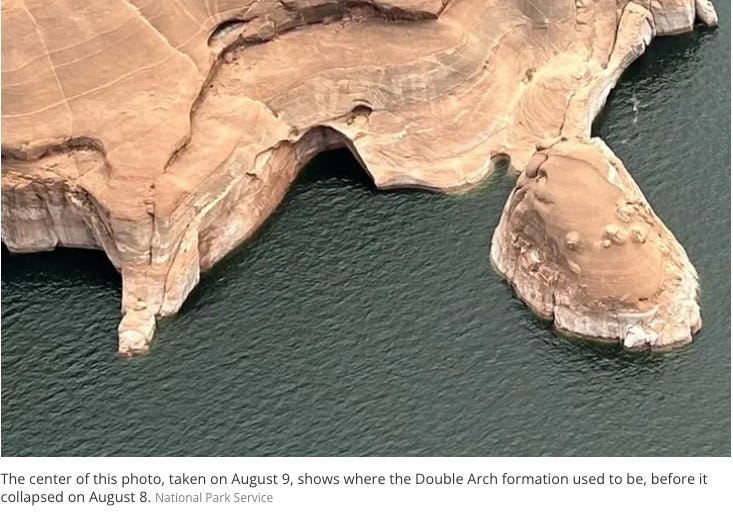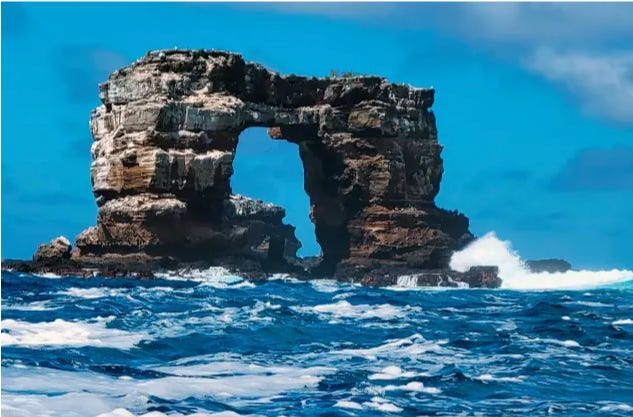When Utah’s ancient and spectacular “Double Arch” suddenly collapsed recently, a professor of geology called it “just a natural process in the life span of an arch.”
And what a spectacular life span it was. A National Park Service statement indicates that “Double Arch” was formed from Navajo sandstone dating to 190 million years ago, during the late Triassic to early Jurassic periods. The statement goes on to reassure us that the sandy formation had already been broken and eroded by weather, wind and rain over the course of many years. So, in other words, it had nothing to do with human-driven climate change.
Nothing to see here. Keep the line moving.
Sorry, it’s jarring. Consider me officially jarred.
Shouldn’t we be concerned that a natural structure that has been in existence for 190 million years spit the bit and had its number called last week? When it seems like the whole world is crashing down around us, it’s rather disconcerting to have 190 million year old rock formations literally crashing down around us!
And here’s what was once called nature’s Toilet Bowl looks like after it’s been flushed.
As with any sudden loss of something that’s been a constant in our lives, since, well, about 185 million years before there was human life, some people have waxed sentimental about this loss.
OK, so the rational side of me understands that natural structures have a life cycle, like trees and people do - and there’s something comforting about that. They die too - only a whole lot more slowly. Like stars. And the rational side of me believes - or wishes to believe - that human beings, who have been around for only a fraction of the time this toilet bowl was rising, had nothing to do with its demise, that climate change did not speed up this process of dissolution. But if human beings are destroying everything else on earth, from coral reefs to glaciers to a 70 percent decline of animal populations over the past 50 years, why not this?
A National Parks spokesperson, Michelle Kerns, did not rule out the human factor, saying,
This event serves as a reminder of our responsibility and need to protect the mineral resources surrounding Lake Powell. These features have a life span that can be influenced or damaged by manmade interventions. While we don’t know what caused this collapse, we will continue to maintain our resource protection efforts on Lake Powell for future generations to enjoy.
And in an AP story, Karen Garthwait, spokesperson for Arches and Canyonlands national parks said:
Our mission is not to freeze time and preserve these structures exactly as they are. Our mission is to preserve the natural processes that create these structures, which of course, is the same process that will eventually undo them as well.
It may be no more than an intellectual exercise, but this grand, geological whodunit leaves me troubled. While no smoking gun - or stick of dynamite - has been located, is it possible that “manmade interventions” are causing more damage to our natural treasures than even these experts can imagine? Can the forces that we humans have unleashed, which are literally changing the shape of Greenland and Antarctica, also playing havoc with our Jurassic era rock formations?
If Double Arch had been the only structure to meet its maker in recent years, that would be one thing. But there’s a disturbing pattern here.
On May of 2003, the stately symbol of the Granite State of New Hampshire, a profile in granite called the Old Man in the Mountain, instantaneously became the Dearly Departed Old Man in the Mountain.
In 2021, another iconic rock formation, Darwin’s Arch, off the coast of the Galápagos Islands, suddenly tumbled to the sea. So much for the survival of the fittest.
Manmade structures are hardly immune. In 2018 a large 220 pound stone suddenly fell from the upper reaches of the Western Wall in Jerusalem.
And recently, homes in Nantucket and the coast of California tumbled into the sea, (fulfilling a prophecy by the great seer Steely Dan).
The God of Change
There is a message here, that we need to understand. Nothing lasts forever. The only thing that is permanent is change itself. Oh, and one other thing. Love. Specifically, divine love.
Isaiah understood that, writing in chapter 54:10, a passage read in the Jewish liturgical cycle at this time of year, in the run-up to the new year.
Isaiah was speaking from the depths of the Babylonian exile, envisioning the ruins of the Temple, but he could just as well have been in Utah, staring at the ruins of Double Arch. But he saw in natural and man-made calamities not as signs of an existential unraveling, but as something more hopeful.
It’s not the unshakability of an eons-old arch that galvanizes our faith, Isaiah says, for we know that the rock’s stability is illusory. In fact, the structure’s very fragility is what awes us, as it defies the laws of gravity, like the earth itself, suspended in space seemingly effortlessly - when all along the arch is fighting, straining, pushing heroically against gravitational and erosive forces so great and so invisible that only it perceives the tenuous nature of its lot. Eventually, like a patient breathing their last, it just has to give way to the inevitable.
Faith has less to do with the permanence of those structures than with the love that helps us to pick up the pieces when they inevitably fall.
What is true for the arch is true for the planet, and true for you and for me.
And while we must fight to preserve and protect our home from the dangers that we have helped to bring about, we also need to go with the flow, embrace change and understand that nothing lasts forever.
I was fascinated by a review by Substack author Claudia Befu, The Religion of the Future: God is Change. In it, she discusses Octavia Butler’s climate-dystopian Parable series from the ‘90s, in which Butler proposes a theology of change called Earthseed, “an invented faith that will blossom like a lotus from the dark depths of destruction to form a community and build a vision for a better world.”
The central verse of Earthseed is the following:
“All that you touch, You Change.
All that you Change, Changes you.
The only lasting truth Is Change.
God is change.”
It’s a fascinating theology, but frankly, Judaism was there long ago.
Teshuvah is supposed to reawaken something in ourselves, enabling us to create something new and beautiful, to see the old with new eyes, to encounter the old in new ways. To change.
The old adage “Change is inevitable - except from a vending machine” no longer holds true. It’s more than inevitable now, and vending machines take credit cards. But when we can get our arms around the change, no matter how unwelcome it is, then we embrace life, and we enhance our potential to make a difference as human beings.
Every breath brings about change. It is said that the average adult takes between 12-16 breaths in a given minute, which translates to about 20,000 per day. And where does that precious breath come from? We get half our oxygen from trees, and the other half, I am told, comes from plankton located far below the surface of the deep, in places like Long Island Sound and the Gulf of Mexico. We are seriously connected to those little guys. There is a flow of life, one living thing connected to the other. Every day of our lives, while asleep and awake, as the force of life is flowing though us, our hearts beat, 72 times per minute. Between 50 and 70 billion cells die each day on every human adult. So you think things don’t change? We’re changing dramatically by the second.
And so was Double Arch. And so is Double Arch, really, because its race has not yet been fully run. A few million years from now, people will be marveling at the refreshing swimming hole that stands in its place, wondering why it has the name “Double Arch.” It’s kind of why I wonder why there’s a place in the book of Joshua called the “Hill of Foreskins.” Joshua 5 explains it, but I still don’t believe it.
I took the photo below in the Jewish Quarter of Jerusalem’s Old City.
Those two kids were playing soccer, using for their goal a reconstructed Roman-era pillar that was likely part of the Second Temple courtyard. But for them it was a soccer goal, a piece of the past made sacred again through human connection. God is not in the pillar - that would be idolatry. One might might say instead that God is in the transformative dynamic of adaptation that brings those children into a deepened relationship with their world, their people, their past. by means of that column.
When I was on the Island of Rhodes a few years ago, I saw a potter at his wheel. It was one of those side excursions they add to tours to give us a chance to buy at factory rates. But this was no factory, it was a studio, and after I had finished annoying people with puns about Grecian urns, I took a look at the potter – and I was astounded at how quickly a lump of clay became a beautifully shaped vase – less than a minute. A little touch here, a little there, and it was complete. And then, just like that, demonstration over, he took some wire in both hands and sliced the vase right down the middle like it was a piece of cheese, and both sides collapsed and it was smushed it into a lump again.
To quote a well-known liturgical poem from the High Holidays, adapted from Jeremiah 18:6, “We are like clay in the hands of the potter.” Constantly changing shape. Continually on a journey toward completion, but never quite getting there. One minute almost whole, the next, a clump of clay and we start all over.
Like Double Arch.
That lovely poem also states that we are glass in the hands of the glassblower. God breathes life into us just as the blower shapes the glass – that divine breath is called neshama. In Kabbalistic lore, that breath then takes a more human form in our bodies, invigorating us with life. The breath that we then exhale, projecting it back out into the world is called nefesh. The give and take of God’s breath and our own, neshama and nefesh, bespeak a very dynamic way of being human.
For we really aren’t human beings. We are human becomings. We are constantly evolving and growing. Evolving, growing and connecting to everything around us. There’s a little bit of each of us in that plankton and in that tree, and in the fallen arches and the Old Man in the Mountain, and certainly in one another, and in every human being on this planet.
Religion isn’t about preserving fossils. It’s not about staying the same. Each of us must adapt in order to grow. It is religion’s job to help us do that, to empower us to deal with change, to give us the sense of security and grounding to go out into the world and to change it. Religion gives us comfort, but it also helps us to stake out our place in this swiftly changing world. Its job is to remove us from our comfort zone, so that we will snap to life – so that we will take advantage of every minute of precious life that we have.
So the little secret is now out: Judaism has a bias toward change. Yes, there are things that remain constant. We need an anchor. And as Isaiah 54:10 notes, that anchor is God’s love, as manifested in an eternal covenant given at Sinai. But while the Torah is canonical and fixed, its interpretation always changes. The words stay the same, but new meanings revolve around them. They ebb and they flow and they adapt.
And just as the canonical words from Sinai will endure forever, so will a certain song penned by an immortal Jewish duo. George Gershwin composed the music in 1937, shortly before his death, and his brother Ira wrote these lyrics shortly after - and he wrote them in George’s memory.
In time the Rockies may crumble
Gibraltar may tumble
They're only made of clay
But our love is here to stay.
The Gershwin brothers turned Isaiah 54:10 into a love song so immortal that it might outlast every arch in Utah - and a few in Colorado too. And it will continue to be covered for generations by great musicians, as it has thus far, from Frank Sinatra to Gene Kelley to Ella Fitzgerald & Louis Armstrong (hear it below - best version ever) to Natalie Cole to Nat King Cole, to Tony Bennett, long after California tumbles into the sea. But the love reflected in this gift from Ira and George Gershwin will remain steadfast forever.
Which is a perfect message for this week of Tu B’Av, the Jewish Valentines’ Day.
Meanwhile, Double Arch has already found a new gig, or a doppelgänger, in Israel, just a few miles from Jerusalem, in a hilltop town called Mevasseret Zion (“Herald of Joy to Zion”), a name immortalized by none other than Isaiah, in chapter 40. This iconic double arch may not be as old as the Utah monument, but it claims to have served billions and billions, and it can be seen from miles away, beckoning dusty pilgrims high up on a mountainside overlooking the main road to the Golden City.
Double Arch is dead. Long live Double Arch!







No comments:
Post a Comment